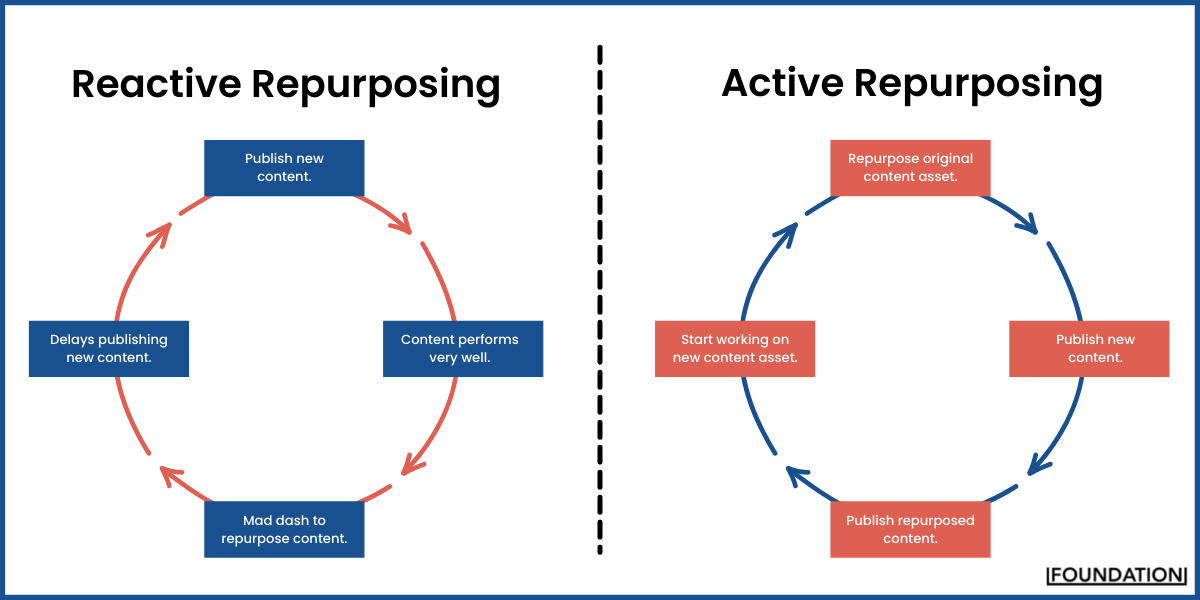Article's Content
What Is Content Repurposing?
Content repurposing is the process of taking existing content, like blog posts, articles, and videos, and transforming it into different types of media to reach a new audience. Content repurposing is a type of content distribution. The goal is to maximize the impact of the content, while minimizing cost and effort. It can be done through techniques like reformatting existing blog posts into video or podcast format, creating an infographic from an article, or combining several blog posts together into an ebook. Content repurposing can help brands quickly expand their reach and create more engagement with their audiences.
In today’s digital age, creating new and fresh content every day can be a daunting task, especially if you are a CMO responsible for managing your company’s content marketing strategy.
Content repurposing is a smart and effective way to breathe new life into your existing content and get more bang for your buck. But what is content repurposing? Why does it matter? And how does it work? In this ultimate guide, we will answer these questions and provide you with practical tips to master content repurposing and take your content marketing to the next level.
Understanding The Types Of Content Repurposing


Reactive repurposing of content is the practice of taking existing content and reusing it in a different way, such as turning a blog post into an infographic or a podcast. This type of repurposing is useful for creating quick and easy content without having to invest much time or resources.
Active repurposing requires more effort but can produce bigger results. It involves analyzing old content to identify areas that could be improved upon, then using the updated information to create new pieces of content. For example, companies can review their most popular blog posts from last year and create an ebook about similar topics with more up-to-date information that appeals to readers who are interested in those topics.
Overall, reactive repurposing is great for quickly generating new and fresh content while active repurposing allows you to create more unique and engaging content that takes advantage of current trends.
Understanding How To Do Content Repurposing
First of all, let’s define content repurposing. Simply put, it’s the process of taking one piece of content and transforming it into another format to reach a new audience or achieve a different objective. For example, you can turn a blog post into a video, a podcast, an infographic, or a series of social media posts. The key is to leverage your existing content assets and make them work harder for you.
So, why does content repurposing matter? There are several reasons. Firstly, it saves you time and resources. Instead of starting from scratch every time you want to create content, you can repurpose what you already have and save yourself hours of work. Secondly, it allows you to reach new audiences. By presenting your content in different formats, you can appeal to people who prefer video, audio, or visual content. Thirdly, it helps you reinforce your message. Repurposing content across different platforms and channels can build brand recognition and credibility with your audience.
Now, let’s talk about how content repurposing works. The first step is to take your best-performing content and assess its potential for repurposing. Look for content that has generated a lot of traffic, engagement, and conversions. Ask yourself how you can transform that content to add value to your audience. For instance, if you have a blog post that has received many shares and comments, you could turn it into a podcast episode where you expand on the topic and share more insights.
Next, you need to choose the right format for your repurposed content. Consider your audience and their preferences. Some people may prefer to read a blog post, while others may prefer to watch a video or listen to a podcast. You should also think about the platform you want to publish your content on. Each platform has its own requirements and limitations, so make sure your content fits the medium.
Once you have decided on the format, it’s time to create your repurposed content. This can involve editing, adding new elements, or repackaging the content in a new way. For example, if you want to turn a webinar into a blog post, you may need to add more visuals and summarize the key points in a concise way.
Finally, you need to promote your repurposed content. Don’t just repurpose your content and hope for the best. You need to get it in front of your audience and promote it on different channels. Use social media, email marketing, and any other relevant platform to amplify your content and attract new readers, listeners, or viewers.
Content repurposing is a powerful tool that can help you streamline your content marketing efforts, reach new audiences, and reinforce your message. By transforming your existing content into new formats, you can save time and resources, while generating more traffic, leads, and conversions. To master content repurposing, you need to choose your best-performing content, choose the right format, create your repurposed content, and promote it on different channels. By following these steps, you can take your content marketing to the next level and achieve greater results. So, start repurposing your content today and see the difference it can make!






